Gluten-Free Bread with Yogurt
This Gluten-Free Bread recipe with yogurt (I use dairy-free to make this a vegan bread) was repeatedly called “the best gluten-free bread ever”! The yogurt adds softness and tang to the fluffy gluten-free bread, giving it a sourdough-like flavor without the need for a starter. You only need seven ingredients and three hours of mostly hands-off time to make this delicious yeast bread.
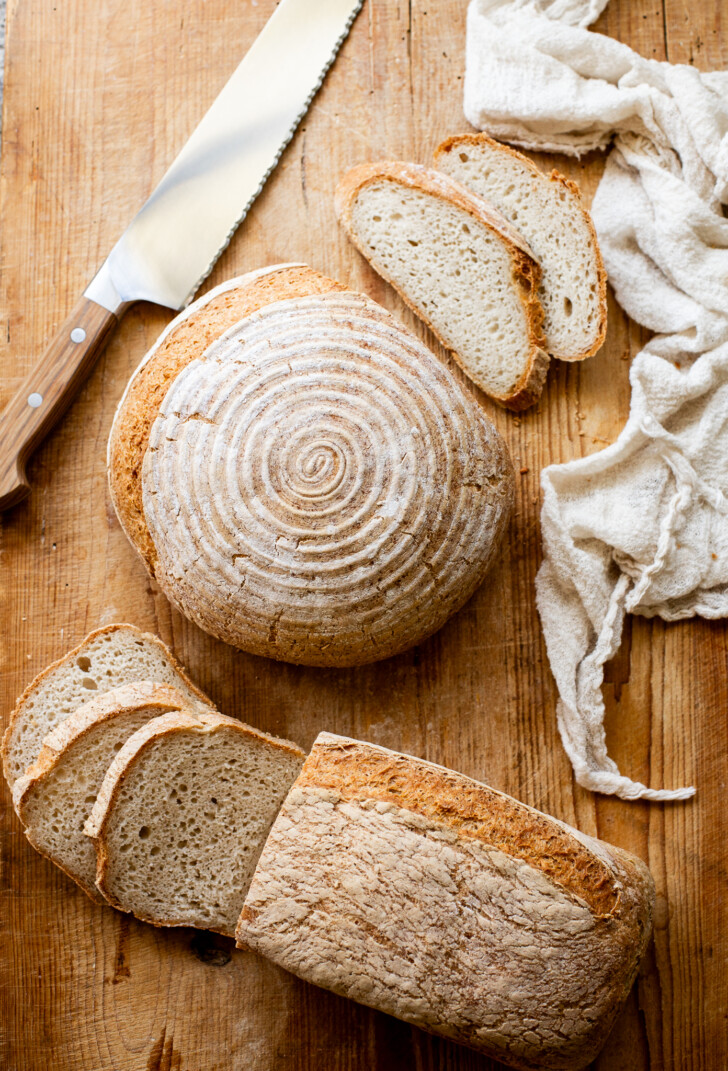
Meet my new favorite gluten-free bread recipe! That’s a big statement since I adore all of my gluten-free bread babies. The classic yeasted gluten-free bread loaf has been a staple in my kitchen for a while and I love its ease. The gluten-free sourdough was my first bread love, but it can take a while to make from start to finish and sometimes I’m impatient.
This new gluten-free yeast bread marries the two: it uses yogurt and apple cider vinegar to give a tanginess to the loaf that’s reminiscent of sourdough bread, but it’s raised with instant yeast, so it only takes less than three hours from start to finish.
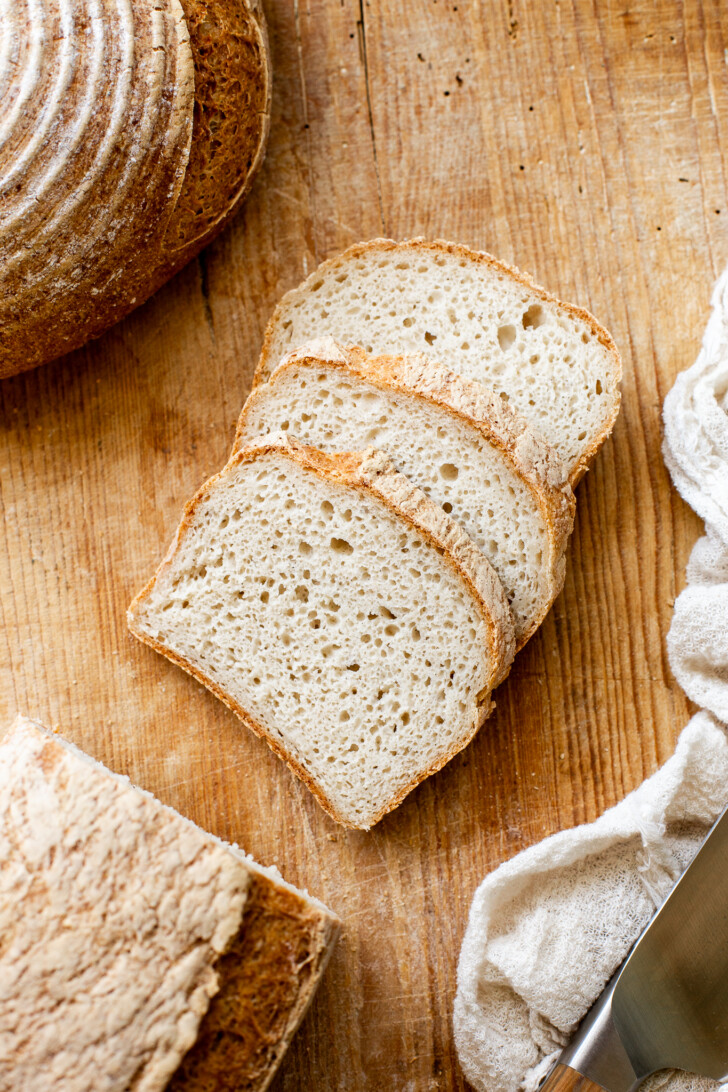
Why you’ll love this easy gluten-free bread:
- Only need seven ingredients
- It’s gluten-free and vegan
- Made with instant yeast
- Only needs to rise for one hour
- Soft, tender & tangy – without the sourdough starter!
- Ready in less than three hours
Ingredients to make Yeasted Gluten-Free Yogurt Bread
A note: I don’t share any volume measurements for this bread, because I find it’s so much easier and more accurate to use weight. Please get a baking scale if you’ll be doing bread baking with any kind of regularity – it will make things much easier and more accurate! Plus, less messy measuring cups :)
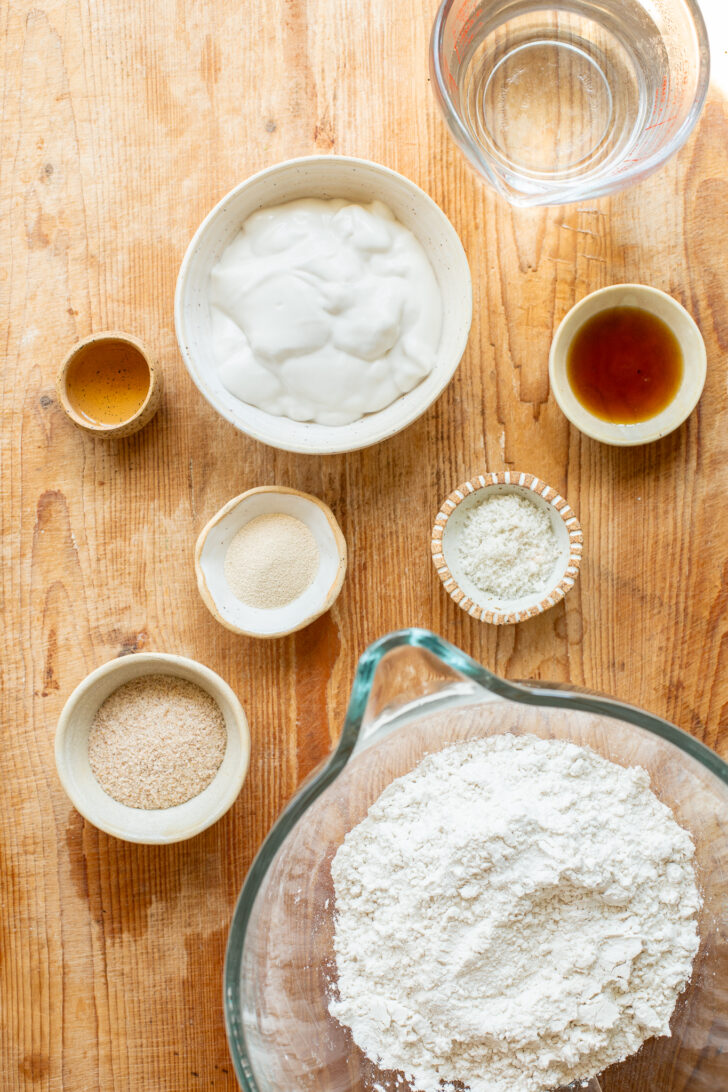
- Psyllium Husk: this is the thickener and “gluten” substitute for this bread loaf. Read all about psyllium husk here.
- Sweetener: I like using raw cane sugar or maple syrup.
- Hot Water: the hot water helps activate the yeast. Use filtered if you can.
- Unsweetened Yogurt: since I’m dairy-free/vegan, I always use unsweetened dairy-free yogurt.
- Apple Cider Vinegar: this adds a tangy flavor to the bread and can help with the rise.
- Gluten-Free Bread Flour Blend: read more below about my favorite gluten-free bread flour blend.
- Sea Salt: for flavor!
- Instant Yeast: I like using instant yeast because it removes the step of activating yeast and makes this super quick and easy to make!
What’s the difference between active dry yeast and instant yeast? Active dry yeast must be activated by warm water before use, usually along with some kind of sugar to help feed the yeast and get it nice and bubbly. Instant yeast is mixed directly into the dry ingredients and is activated when the dough is mixed together. I find it easier to troubleshoot with active dry yeast because if your instant yeast doesn’t activate, you need to restart the whole recipe.
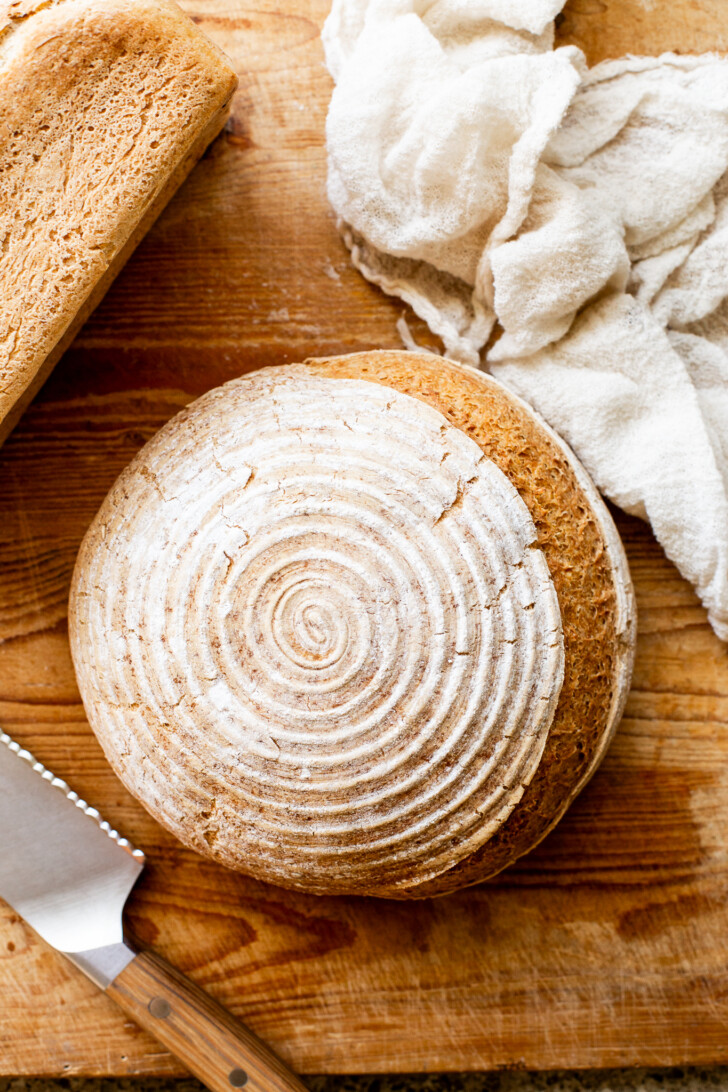
What’s the best gluten-free bread flour to use?
I always use my homemade gluten-free bread flour blend for this recipe and it works fantastically.
The only other pre-mixed flour blend I’ve tried is this multi-blend flour from Vitacost, which is made with similar ingredients to my homemade blend and makes for a delicious fluffy bread.
I have not tested this recipe with any blends that incorporate xantham gum or guar gum, so I can’t say how blends that add those gums would affect the recipe. Experiment as you please, but I can’t make any guarantees beyond these two blends.
To make your own gluten-free flour mix for this loaf, you can use about 40% starches (like potato starch, corn starch, arrowroot starch, and/or tapioca starch) to 60% whole grain gluten-free flours (like brown rice flour, oat flour, white rice flour, sorghum flour, millet flour teff flour, or buckwheat flour). Each has its own properties and flavors, but it can be super fun to experiment here and see which combination makes for your favorite loaf.
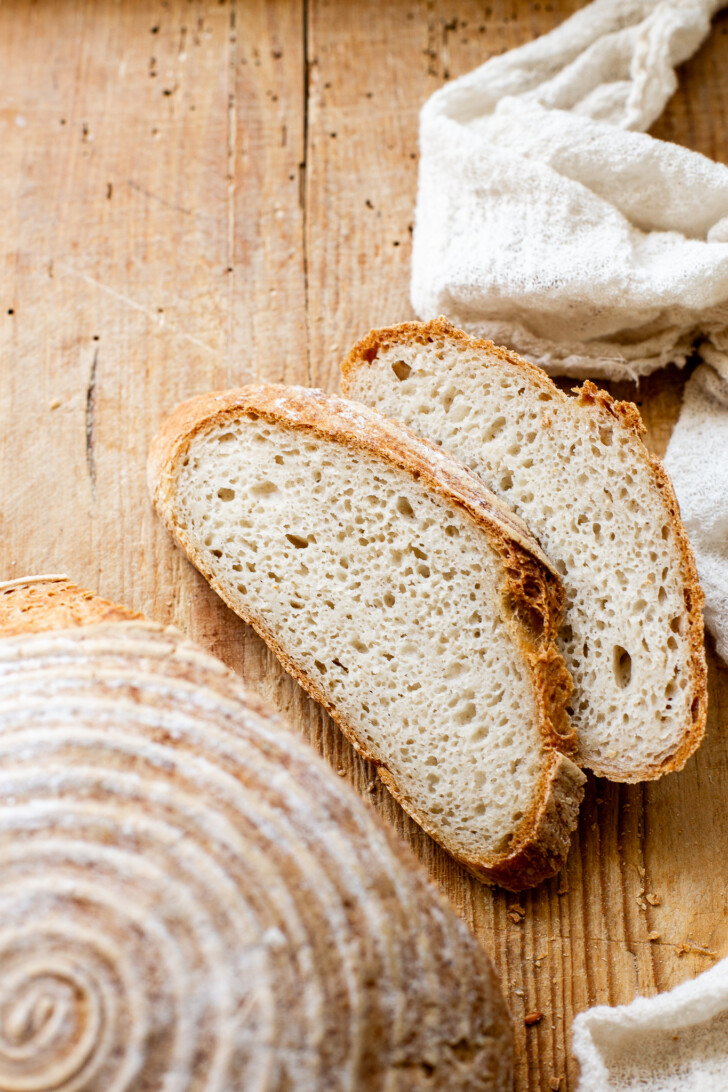
What is psyllium husk? Do I need it?
You can read all about psyllium husk here! But, the short answer is, the psyllium husk is the fibrous husk of a seed, and when combined with water, it creates a thick gel. The psyllium gel helps make your gluten-free bread dough easier to handle and shape.
From my experiments: you need psyllium husk for good gluten-free bread. It is necessary for this recipe and almost all of my gluten-free bread recipes. I don’t recommend skipping it or replacing it with anything else. It makes the dough workable, so it doesn’t squish all over the place. It’s also what makes your bread chewy and stretchy.
NOTE: psyllium husk and psyllium husk powder are different. You want the full husk. I usually find it in the supplement area of most grocery stores, and you can also find it for sale online.
This recipe uses yogurt – can it be made dairy-free/vegan?
YES! In fact, I’m dairy-free, so all of my tests use dairy-free yogurt. I tested this with both cashew yogurt and coconut yogurt, and both were delicious. I’m sure regular dairy yogurt will also work great. Just be sure to use an unsweetened/unflavored yogurt (unless you want to use the yogurt as a flavoring agent).
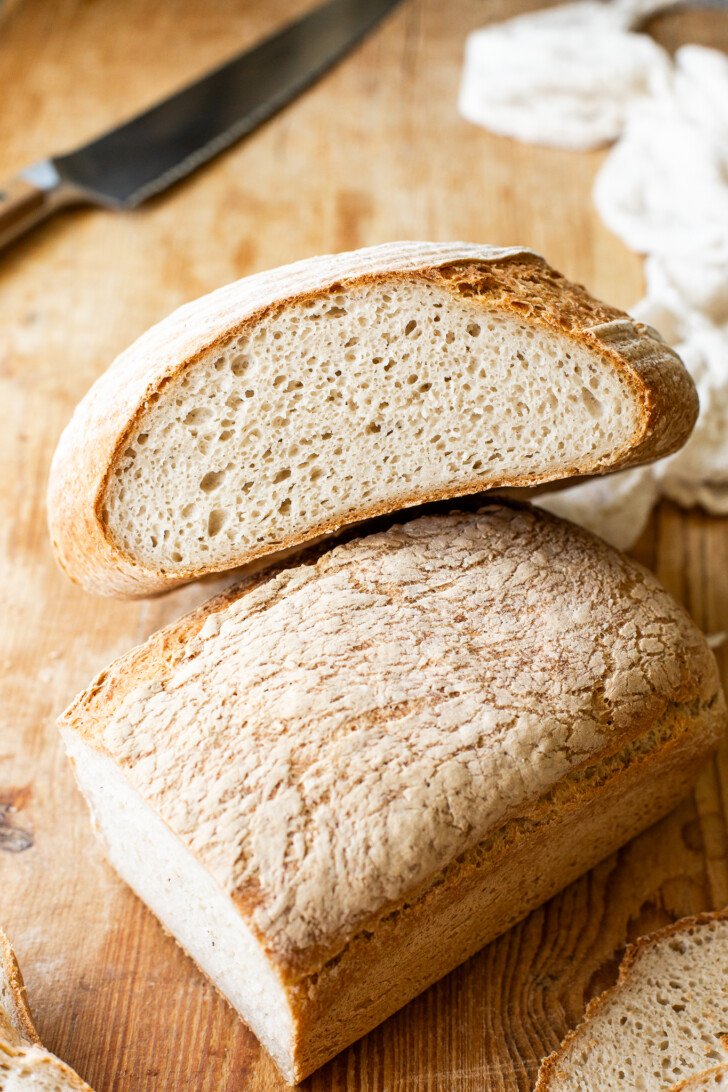
Making gluten-free bread with yogurt
Make the psyllium gel. Mix together the psyllium husk, sweetener, yogurt, apple cider vinegar, and water. Whisk and let it set for a few minutes until thickened and gel-like.
Mix together your dry ingredients. In a large mixing bowl or the bowl of a stand mixer, whisk together the gluten-free flour blend, instant yeast, and salt. Whisk to combine.
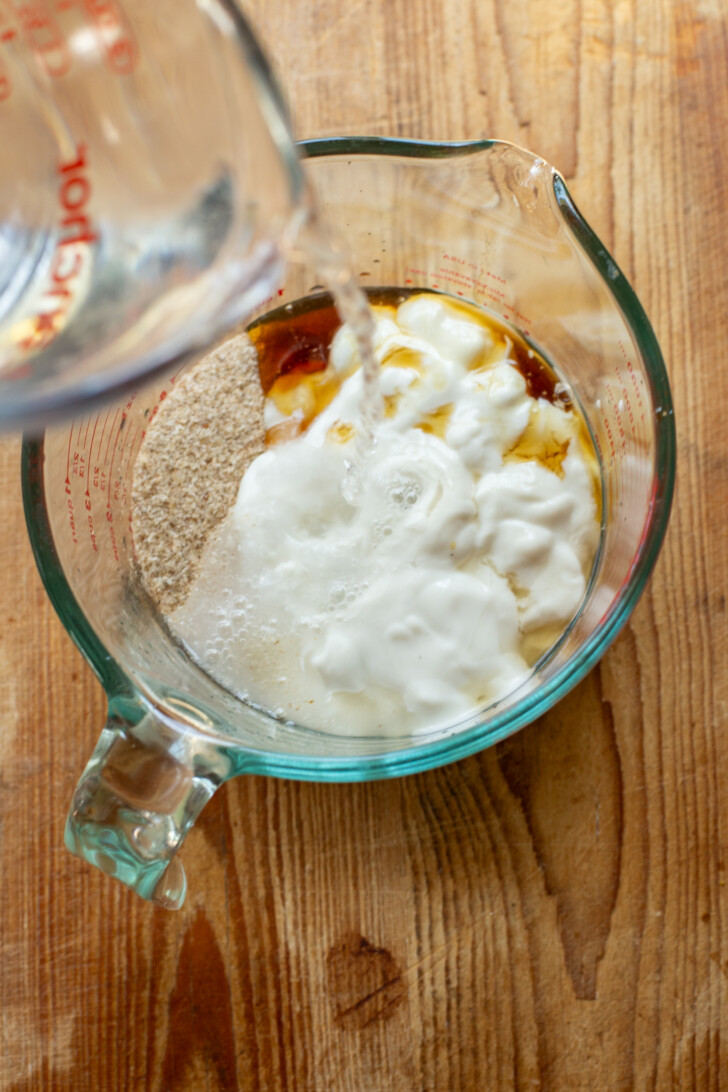
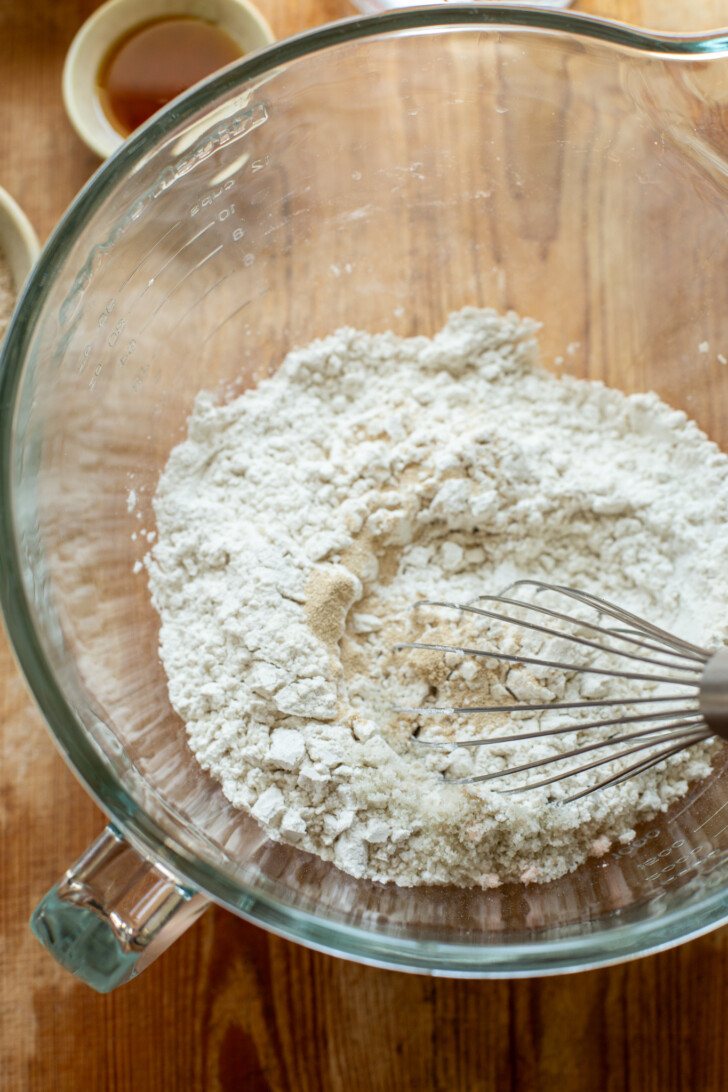
Combine everything and form into a dough. I mix everything in my stand mixer with the dough hook, but you can also do this by hand. If mixing by hand, I like to use a dough whisk to get it combined. Then, turn it out onto the countertop and use my hands to knead the rest of the flour in. The dough should feel pretty soft and puffy – this is not a super dense dough.
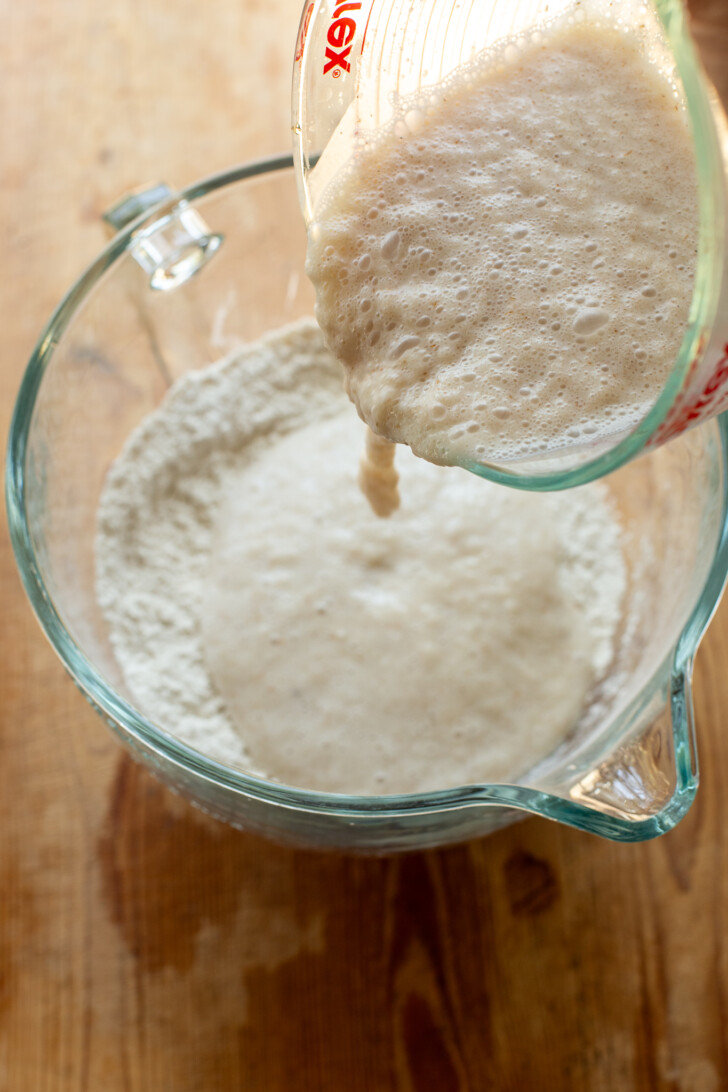
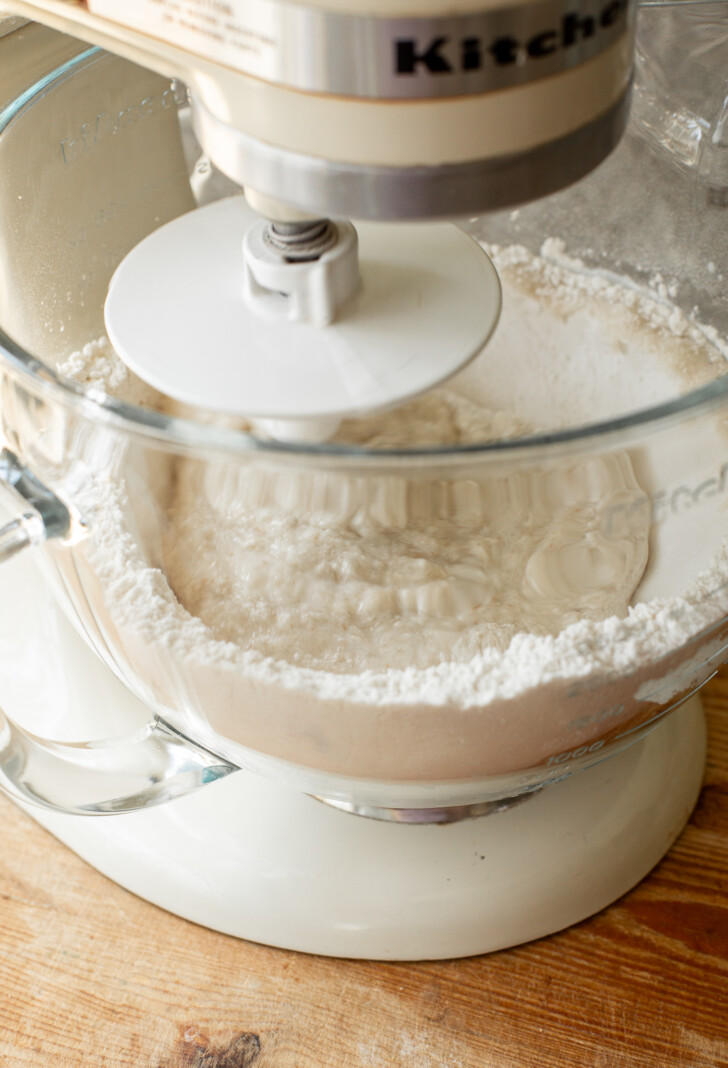
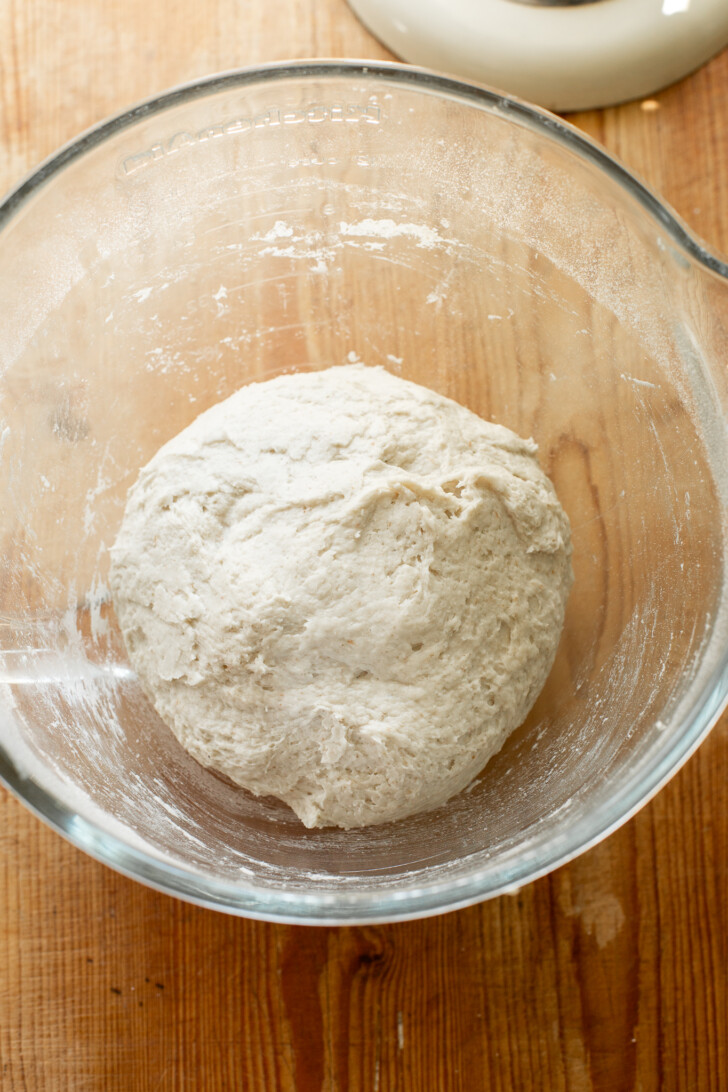
Knead and shape the dough. Use your hands to knead the dough into your desired shape/shapes. Then, you’ll place it in the banneton or loaf pan for the proof.
Rise, score, and bake! Let the loaf rise for one hour in a warm place, or until it’s light and puffy to the touch, and preheat the oven to 425℉ while it rises. Once the bread has risen, score it with a knife or lame (flipping it out of the banneton onto parchment, or a silicone sling if baking in a Dutch oven). Then, place it into your baking vessel. Bake for 1 hour and 20 minutes, removing the lid for the last 20 if baking in a Dutch oven.
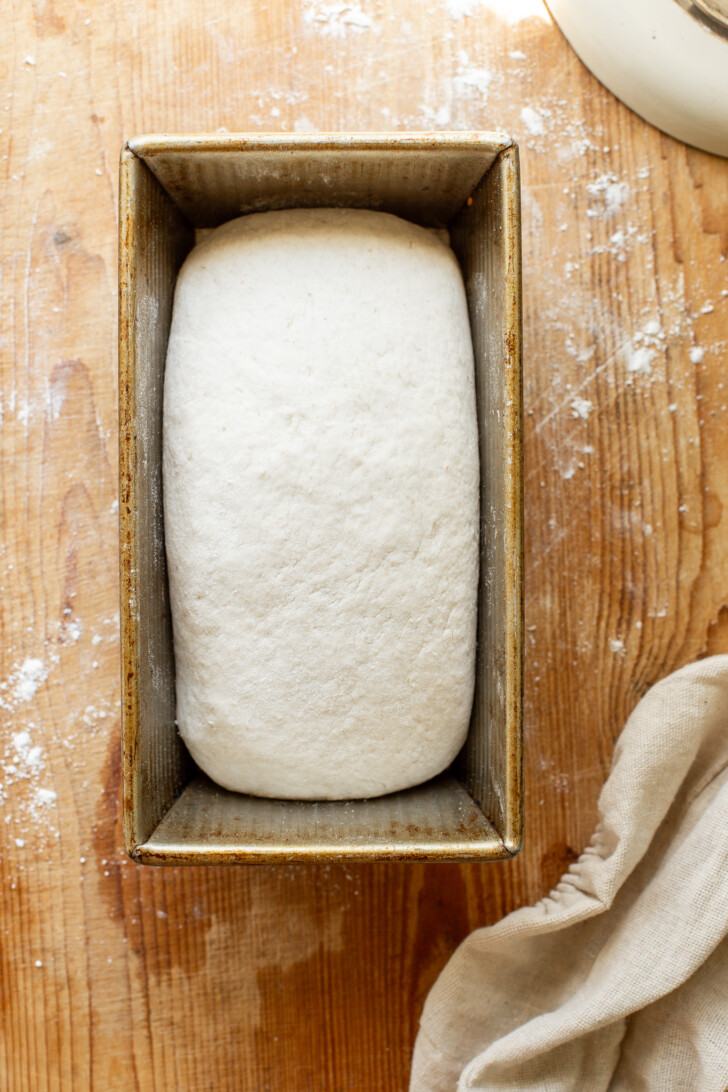
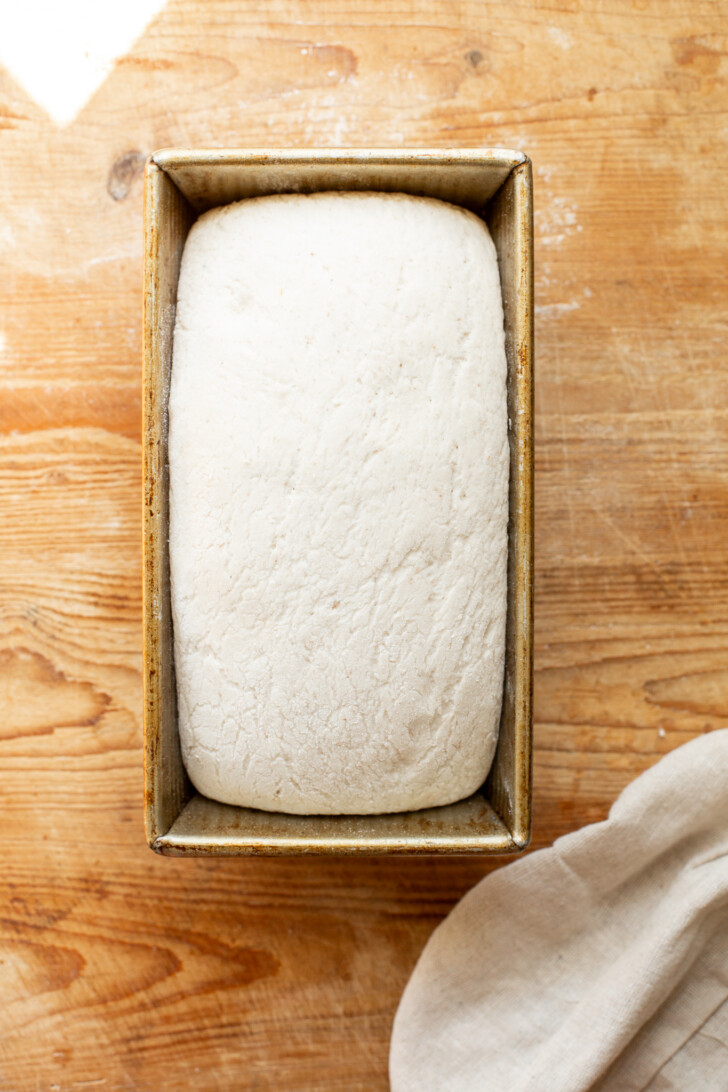
Remove from the baking pan. Turn the oven off, place the loaf directly on the oven rack, and prop the oven door open. I usually use a wooden spoon for this. Let the bread start to cool inside of the oven for 30 minutes to 1 hour. This helps to finish cooking off any gumminess inside of the loaf.
Cool completely. This is definitely the hardest part, but you really need to let the loaf cool completely so the inside can set. I usually try to let it cool overnight. You definitely want it to be fully cool to the touch before cutting into your loaf. Then…slice and eat! Definitely the best part :)
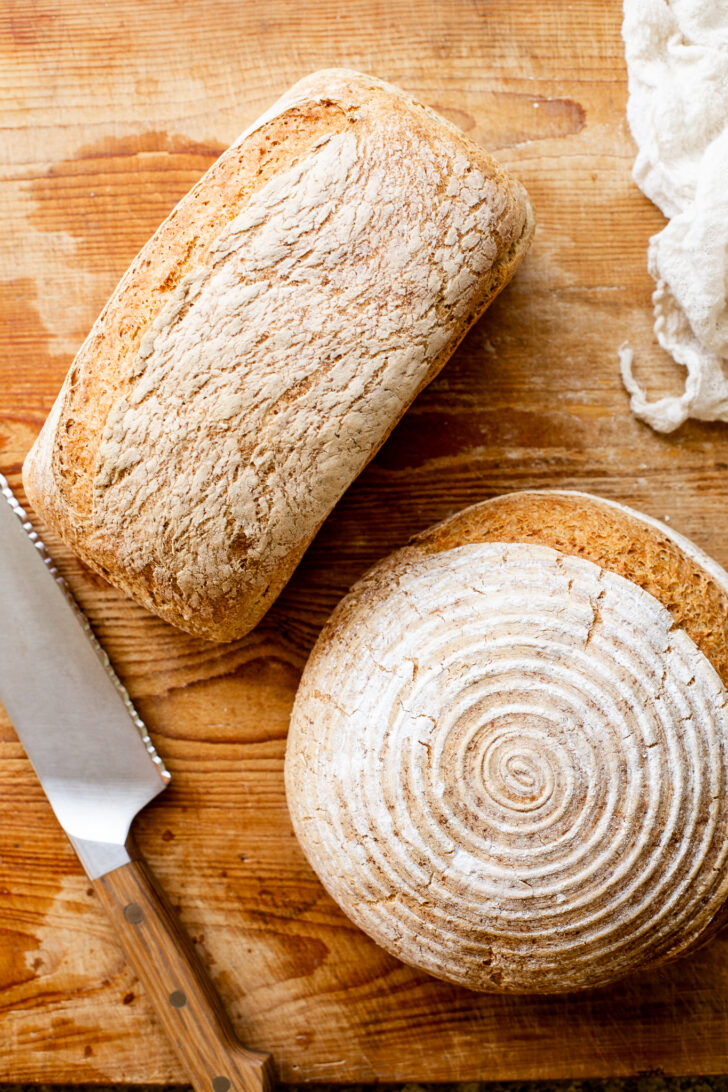
How to store gluten-free bread
At room temperature: You can also keep it in a bag or container at room temperature for up to 3 days. The bread will start drying out by day 3 or 4, so I recommend freezing it by then.
In the refrigerator: place into an airtight bag for up to 1 week.
In the freezer: I like to slice the whole loaf and keep it in the freezer. It will store well for up to 6 months. Place sheets of parchment between each slice to prevent them from sticking together.
To reheat from frozen: microwave the bread slices for 30-60 seconds or place in the oven at 350F for 5 minutes, or until you’ve reached your desired level of toastiness.
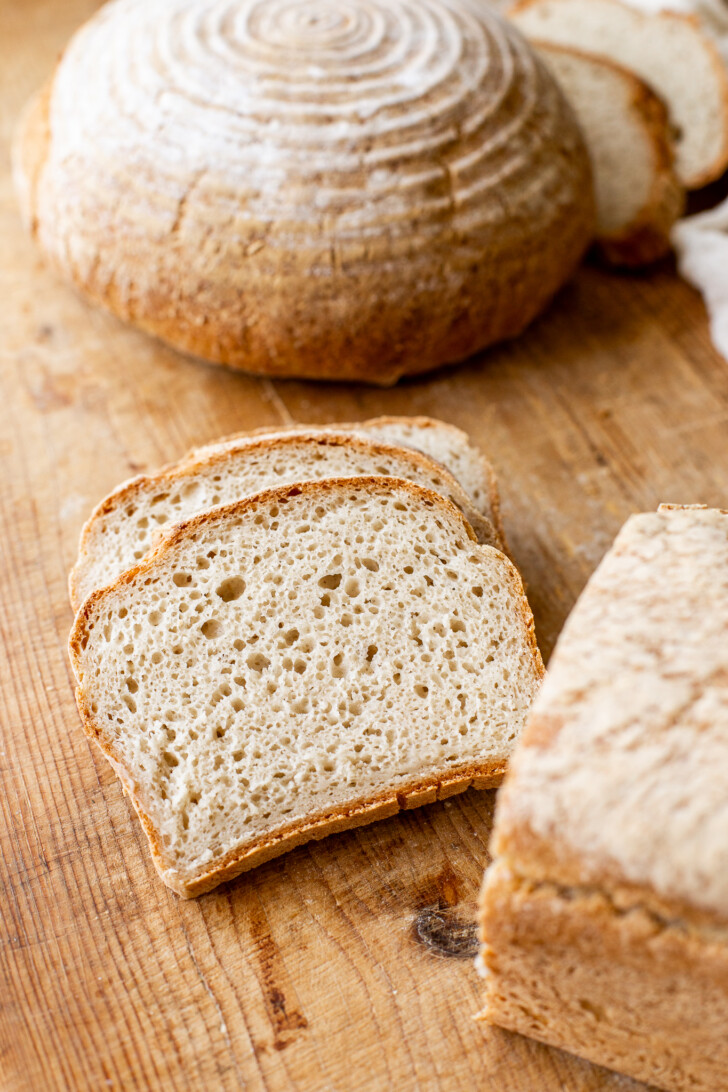
More gluten-free yeast bread recipes
- Classic Gluten-Free Bread
- Gluten-Free Bagels
- Gluten-Free Rye-Style Bread
- The Best Gluten-Free Pizza Crust
- Gluten-Free Cinnamon Raisin Bread
- Easy Gluten-Free Focaccia Bread
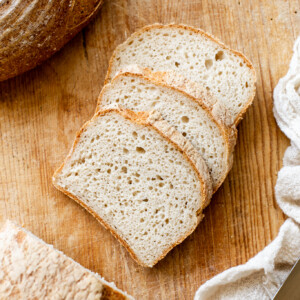
Gluten-Free Bread with Yogurt
- Prep Time: 15 minutes
- Rising Time: 1 hour
- Cook Time: 1 hour 20 minutes
- Total Time: 2 hours 35 minutes
- Yield: 1 loaf 1x
- Category: Bread
- Method: Baking
- Cuisine: American
- Diet: Gluten Free
Description
This Gluten-Free Bread recipe with yogurt (I use dairy-free to make this a vegan bread) was repeatedly called “the best gluten-free bread ever”! The yogurt adds softness and tang to the fluffy gluten-free bread, giving it a sourdough-like flavor without the need for a starter. You only need seven ingredients and three hours of mostly hands-off time to make this delicious yeast bread.
Ingredients
- 18g psyllium husk
- 20g maple syrup or cane sugar
- 320g hot water
- 200g unsweetened yogurt, I used dairy-free cashew yogurt, don’t use a super thick yogurt here – a thinner one works great
- 5g (1 teaspoon) apple cider vinegar
- 460g gluten-free bread flour blend
- 12g sea salt
- 7g instant yeast, make sure it’s gluten-free, see Notes for how to use active dry yeast instead
Instructions
- In a bowl or large liquid measuring cup, mix together the psyllium husk, sweetener, water, yogurt, and apple cider vinegar. Whisk together, breaking up the psyllium, and let it set for a few minutes until it’s thickened and gel-like.
-
In a large mixing bowl or the bowl of your stand mixer, mix together all of your flour blend, salt, and yeast. Whisk to combine.
-
Add the psyllium gel to your dry ingredients. If using a stand mixer, fit it with the dough hook and let it mix up the dough until combined and smooth, scraping down the sides a few times during the process, and flipping the dough around to make sure it’s fully mixed on the bottom too. You can also do this by hand. If doing it by hand, I like using a dough whisk to get it mostly combined. Then, turn it out onto the countertop and use your hands to knead the rest of the flour in. The dough should feel pretty soft and light – this is not a super dense dough. If your dough seems dense or dry, it could be from a difference in yogurt texture. Add up to 30g extra water to get to the right consistency if it seems necessary to make your dough workable!
-
Cover with a tea towel and let the loaf rise for one hour in a warm place. It should just about double in size, and it will feel light and puffy to the touch when it’s ready. Preheat the oven to 425℉ while it rises with a Dutch oven inside if using.
-
Once it’s risen, score the bread (carefully flipping it out of the banneton onto parchment or a silicone sling if baking in a Dutch oven). If you’re baking in a loaf pan, you may want to brush the top with oil to get a nice golden crust and help soften it slightly.
-
Place into your baking vessel if using a Dutch oven. If using a loaf pan, just place it right into the oven. Bake for 1 hour and 20 minutes, removing the lid for the last 15 minutes if baking in a Dutch oven. It should be golden brown and crusty.
-
Remove from the baking pan. Turn the oven off, place the loaf directly on the oven rack, and prop the oven door open. Let the bread start to cool inside of the oven for 30 minutes to 1 hour. This helps to finish cooking off any gumminess inside of the loaf.
-
Remove from the oven and set on a cooling rack to cool completely. This is definitely the hardest part, but you really need to let the loaf cool completely so the inside can set. I try to let it cool overnight, but you’ll want to let it cool for at least four to five hours. It should be fully cool to the touch before cutting into your loaf.
-
Slice and eat. This bread is great raw, toasted, or however else you want to enjoy it!
- To store, I like to slice the whole loaf and keep it in the freezer. It will store well for up to 6 months. You can also keep it in a bag or container at room temperature for up to 2 days, or in the refrigerator in an airtight bag for up to 1 week.
Notes
If your bread has gumminess, this is generally from the liquid/flour ratio being off. It can be exasperated by coarsely-milled flours, not letting the psyllium gel for long enough, and incorrect baking times. To help mitigate this, you can let the bread cool for a while in the oven with the door propped open – this helps it finish baking slowly and dries the center out. Also, make sure to cool the bread completely before you cut into it.
To use active dry yeast: start by activating the yeast. In a small bowl, combine the yeast with the sweetener of your choice and 100g of warm water (from the 320g of water), between 100-110℉. It should feel warm, but not hot, to the touch. Let it sit to activate for about 10 to 15 minutes. You should notice it start to to bubble, and then it will get nice and foamy on top. Once activated, continue on with the recipe by combining the yeast with the psyllium husk/water/yogurt mixture.
How to store gluten-free bread
- At room temperature: You can also keep it in a bag or container at room temperature for up to 3 days. The bread will start drying out by day 3 or 4, so I recommend freezing it by then.
- In the refrigerator: place into an airtight bag for up to 1 week.
- In the freezer: I like to slice the whole loaf and keep it in the freezer. It will store well for up to 6 months. Place sheets of parchment between each slice to prevent them from sticking together.
- To reheat from frozen: microwave the bread slices for 30-60 seconds or place them in the oven at 350F for 5 minutes, or until you’ve reached your desired level of toastiness.








If you activate the dry yeast with the 100 grams of water and the sweetener, would you still add an additional 320g of hot water to the ingredients or would you reduce the water to 220g? Today when making the recipe I did reduce the water and I’m thinking that was incorrect as my dough looks much drier than what I’m seeing in your photos. I’m proofing the bread now. We’ll see if it rises.
Hi Renee, you’d reduce to 220 – the total amount of water is 320g either way! I updated the recipe to hopefully make that more clear. What kind of yogurt did you use?
Can we use Greek yogurt?
Hi Elisa, that should be ok – however if it’s super thick, you may need to add a little water to get to the right consistency since I tested this recipe with runnier yogurts.
Hi! I’ve made this bread twice and it’s very good! I’m still trying to figure out how to get it to rise more. But my question for you is, what loaf pan are you using? What are the dimensions? Is the linked pan the right one?
thanks
Hi Jennifer, glad you’re enjoying it! Is your yeast fresh & active? Are you getting a good crumb/rise? Sometimes 1.5x the recipe helps give you the tall loaf you’re looking for if using a bigger pan. The 1-pound loaf pan (8.5 x 4.5) is the one I use. You can use a smaller one if you’d like a taller loaf.
Quickest of all her bread recipes so far! Only one rise is a complete game changer for me! I used plain, unsweetened Activia yogurt and the consistency was perfect! Very quick to come together and form right into my loaf pan. Fluffy and tastes like sourdough! I toasted the first piece w Nutella lol Make this recipe!!
So glad you loved it, Vanessa!! Thanks so much for the feedback and sweet review :D
Which yoghurt are you using? I used Forager’s cashew yoghurt, which was great flavor-wise, but not very runny at all (and my loaf is definitely dense, not fluffy – though still delicious!)
Hi Lydia, did the dough seem dense? I’ve found certain thicker yogurts require a little bit more water if the yogurt is thick, which is why I mention adding extra water if the dough is super dense. This recipe turns out best when the dough is lighter. I personally tested with Cocojune and Trader Joe’s cashew yogurt. Also, did you use my flour blend or a different one, as that can also have an impact? Glad you enjoyed the flavor, regardless!
Ooooh, I can easily get both of those yoghurts, yay! Yeah, the dough did seem a little dense, but as it was my first time with this recipe (using your amazing bread flour blend!) I didn’t want to mess around too much – basically this was my baseline test. But will change the yoghurt out for the next one and adjust the water if the dough still seems similarly dense. Such a great recipe, though, even a little dense it’s totally delicious! Going to be making it on repeat all winter :-)
Oh. My. Gosh. This bread is AMAZING!!!! I have tried many gluten-free bread recipes, and they’ve all been ok, but not exactly like real deal bread. This is THE recipe I will use forever and ever, no more searching. I love that it’s healthy too and got a good protein boost from the yogurt. That sourdough-like tang, oh man. DELISH!
I’m both excited and scared to try this! Two questions-do I grease the loaf pan before proofing the bread and two once the bread has risen in the loaf pan can I just bake it in that pan-or am I supposed to transfer it to a different loaf pan and shape it?
Hi Courtney, my pan is non stick so I don’t grease it but if yours isn’t, you may want to line with parchment – I wouldn’t grease because it can make it harder for the dough to rise. Bake right in the pan, you don’t want to let the bubbles fall by moving it. Enjoy!
My favorite, go-to recipe for a quick and delicious loaf of gluten free bread. I’ve been using Bakerita’s sourdough bread recipe since its conception and was so happy when she released a yeasted recipe for when I’m wanting a quick rise. A winning recipe in my house and nobody believes it is gluten free!
So glad you’re loving it Rach!!! :)